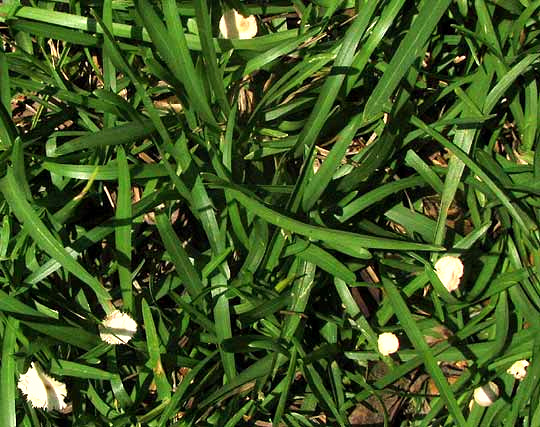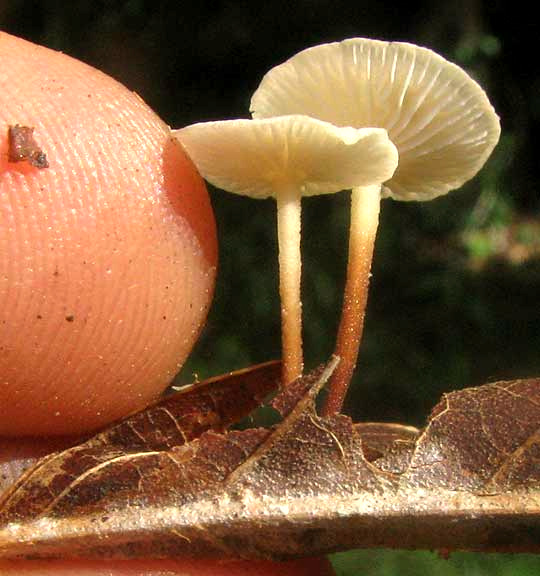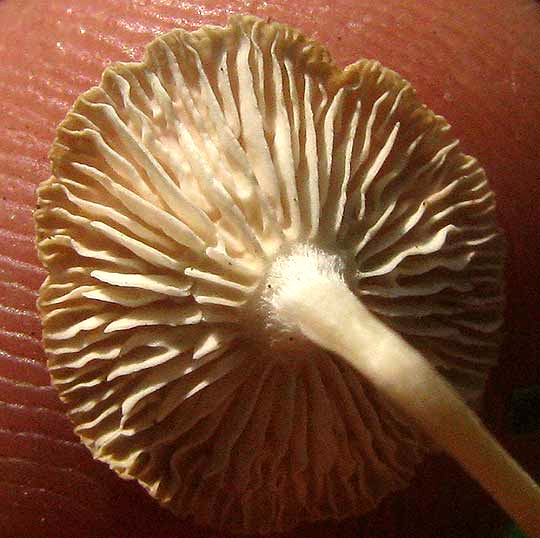Excerpts from Jim Conrad's
Naturalist Newsletter
from the July 29, 2012 Newsletter issued from the woods of the Loess Hill Region a few miles east of Natchez, Mississippi, USA
TINY MARASMIUS MUSHROOMS
Much in contrast to most of the US, here in southwestern Mississippi our July has been fairly rainy with many afternoon storms. In the grassy orchard huge numbers of a thumbnail-sized-and-smaller, pale tan mushroom become very conspicuous soon after any good rain, as shown below:

If rains fail for a couple of days the mushrooms shrivel up, contort into very unmushroom-like shapes, and look completely dead, but as soon as the next rain comes they resume their former shapes, maybe only with their cap rims looking a bit more ragged. In the science dealing with fungi, mycology, this ability for a dried-out mushroom to assume its previous proportions is known as "marcescence."
These orchard mushrooms are not rooted in soil but rather on individual or stuck-together leaf blades or single grass stems. You can see two arising from a moldy Cherrybark Oak leaf, with the tip of my index finger nudging in from the side for scale, below:

In that picture notice the white, powdery stuff on the leaf's undersurface. That's the actual "main body" of the fungus, the mycelium. Mushrooms are mere reproductive structures of the white stuff, which is actually a complex, intricately branching network of threadlike fungal hyphae. The individual thread is a hypha, the clumped-together hyphae form mycelium. The hypha strand grows through the leaf's dead tissue breaking it down into chemical components the fungus uses as food. Doing this, the fungus performs a profoundly important ecological function by contributing to the leaf's decomposition, and helping make nutrients locked in the leaf available to other living organisms.
You can see the underside of this mushroom's cap, showing the gills from which spores fall, below:

Without being able to examine our tiny, marcescent orchard mushroom's white spores with a microscope I can't be sure which species it is, but my best guess is that it's MARASMIUS DELECTANS, a common species in decaying leaf litter, especially oak leaves, widely distributed in North America east of the Rockies. Besides its ecology (on a decaying oak leaf), size, and cap and spore color, an important field mark for this species is its slender, tough stem that is dark below but very pale near the cap.
Marasmius species are numerous and often abundant. If you have similar ones around your house and want to figure out which species you have, Michael Kuo at MushroomExpert.Com provides a fine introduction to the genus and a good key to species at http://www.mushroomexpert.com/marasmius.html.